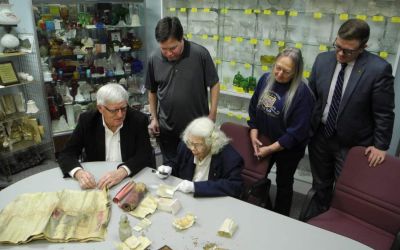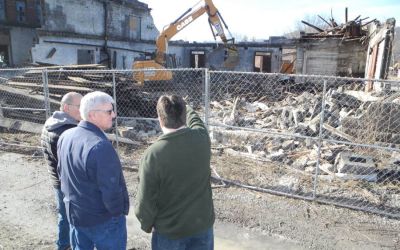About the Former Brooke Glass Factory
The building in downtown Wellsburg known as ‘Brooke Glass’ was built in 1879 with the companies Riverside Glass Works, Crescent Glass Co., and lastly Brooke Glass inhabiting it. Many leftover glass pieces, shards, and office remnants were found while in the process of redeveloping the property. The site is ready for a company to add to its long-standing history.
The building was acquired by the BDC with the assistance of the Wellsburg Urban Redevelopment Authority (URA) in March 2015 and was originally planned to be entirely razed. One of the three original sections was kept in cooperation with the State Historical Preservation Office (SHPO) and USEPA. We received a $5,000 Claude W. Benedum Foundation FOCUS grant and leveraged $542,000 additional funding for remediation and cleanup. This project was made possible thanks to USEPA, West Virginia Northern Brownfields Assistance Center, Brooke-Hancock Regional Development Council, and the West Virginia Department of Environmental Protection (WVDEP).

WELLSBURG – As crews proceeded to raze the front portion of the former Brooke Glass factory, they made an unusual find: hidden in a cement block at the southwest corner were a small ceramic container, a small glass jar, a thin tin box and what appeared to be two thick rolls of papers.Marvin Six, acting director of the Business Development Corp. of the Northern Panhandle, said after learning of them, he had to find out what was inside and he had to share them with the Brooke County Museum and Cultural Center.
It’s not the first time the economic development group has passed items found in the 140-year-old building on to the museum.
After acquiring the Eighth Street structure several years ago and pursuing environmental rehabilitation of the site, the BDC donated molds for several glass pieces produced by the company and a briefcase containing business cards and samples belonging to former president Henry Rithner III.
And that was where Six and museum volunteers Ruby Greathouse and Bobbi Elliott set about investigating the newfound items with help from David Rithner, the last vice president of Brooke Glass; and Brooke County Commissioner A.J. Thomas.
One of the rolled papers was found to be the Feb. 2, 1904 issue of the Pan-Handle News, a Wellsburg newspaper that covered local, national and international news. On the front page is a large photo of Henry Gassaway Davis with a caption noting his recent nomination as vice president.
Details of the nomination are concealed by dirt and dust embedded in the yellowed paper.
But an Internet search reveals Davis was a millionaire and senator from West Virginia named the National Democratic Party’s candidate for U.S. vice president.
Davis and presidential hopeful Alton B. Parker, a New York judge, would lose to Charles W. Fairbanks and Theodore Roosevelt, respectively, but Davis would go on to help establish Davis & Elkins College.
Elliott slowly opened another roll to reveal a 1904 catalog of merchandise sold by Riverside Glass, the company that built the factory in 1878.
Within the catalog’s pages was a separate, smaller booklet listing prices for Riverside’s products.
Six noted many of the pages were stained by water and asked whether the building had taken in water during the city’s various floods.
Rithner said he’s been told water reached the second floor in 1936 but during floods in his lifetime, it did not rise very high.
“A couple of times it came in this much,” he said, holding two fingers apart to indicate about 2 inches, then adding, “just enough to be a pain, to make us clean everything.”
Dye from the catalog’s red cover had leaked onto the ceramic container, giving a pink cast to the small replica of a traveling trunk, complete with a keyhole and handles.
Into the ceramic container had been placed a neatly folded, small sheet of paper. Yellow but clean, the paper appeared to have been protected by its loosely fitting lid.
The museum volunteers still are working to decipher the writing, which appears to refer to Thomas Carlton, apparently a manager at the factory. Within the cracked glass jar was a small card. Folded in half but still stiff, it bears the name Miss Jessie Anne Charlton in italic print.
Greathouse said such cards often were used for graduation announcements.
The contents of the tin box didn’t fare as well, as one end of the rusted container came off, leaving the folded pieces of newsprint inside crumbling scraps of paper.
Six said the combination of items seems to reflect an effort, as with many time capsules, to present items of national, local and personal importance.
Rithner said he’s curious about the occasion for it, noting the factory had been built years before.
But he noted it was purchased in 1911 by his great-grandfather, Henry Rithner I, and a business partner after their bottle-making plant on the city’s north end was destroyed by fire.
Rithner said staff at Riverside may have foreseen their company’s closing before planting the time capsule.
Later redubbed Brooke Glass, Crescent Glass added both the front section and a rear section, which was razed years ago after a portion fell onto the adjacent paved trail.
The BDC had planned to demolish the entire building before it was advised the center section could be preserved. The group hopes to restore the buildng and attract a new occupant.

WELLSBURG — As crews set about razing the front portion of the former Brooke Glass factory on Eighth Street, David Rithner, who served as the company’s last vice president, shared history and memories of the 140-year-old building with leaders of the Business Development Corp. of the Northern Panhandle, who hope to redevelop the property.
The BDC has used about $240,000 in federal, state and local funds to assess and perform environmental remediation of the two-story building and two-acre site.
BDC Acting Director Marvin Six said the group had planned to demolish the entire structure but learned the central section, which had been occupied by the company’s production line, was structurally sound.
He said the original building had stood at the rear but was razed years ago after a portion of it fell onto the adjacent paved trail.
Six said the roof of the front section, which had been used for offices and storage, was found to be very unstable, with support beams for the roof at risk of collapsing.
Rithner said the original rear section was built in 1879 by Riverside Glass, an earlier glass manufacturer that closed in the early 1900s. He said it was bought in 1911 by his great-grandfather, Henry Rithner I, and a business partner who then owned a company known as Crescent Glass after their own glass factory on the city’s north end was destroyed by a fire.
Established in 1908, Crescent was one of 37 glass factories that once operated in Brooke County, most of them in Wellsburg.
During the years, two sections were added to the former Riverside Glass building to facilitate Crescent’s production of an assortment of glass products, including lenses for railroad lanterns, head and taillights for early automobiles and bottles for various products.
In 1980 its name was changed to Brooke Glass.
Rithner recalled a period when up to 125 workers produced more than 30,000 candle holders per day.
“It was a madhouse. It was crowded in there,” he said.
His late father, Henry Rithner III, was the company’s last president. A graduate of Bethany College, where he majored in chemistry, he had completed studies in glass technology at the New York State Ceramics School.
David Rithner said the company had a record year in sales just a few years before it closed in 2001.
Rithner blames the closing on competition from Chinese glass companies which, in addition to being subsidized by their government, used designs stolen from Brooke Glass, he said.
Rithner said it’s rare that former glass factories are repurposed because they were built with little insulation to allow the tremendous heat used in glass production to be released outside.
“In the shops it might be as hot as 120 degrees,” he said.
Under the BDC’s direction, crews have removed assorted hazardous materials commonly used in the production of glass.
They include arsenic, cobalt and cadmium, which all were used to produce colored glass.
“We came across several unmarked containers,” said Six, who added that like many old buildings, the former factory also contained lead paint and asbestos.
Six said some asbestos remains in the existing section but it is in panels that can be removed without harm “as long as you don’t break them.”
He said for such projects the BDC may apply for funds from the U.S. Environmental Protection Agency that aren’t available to private property owners.
“We get bad buildings and properties and try to clean them up the best we can and try to get them into the hands of private developers,” Six said.
He said because the building is part of the city’s historic district and federal and state funds are being used, its history must be acknowledged in some way inside to comply with the state Historic Preservation Office.
Six noted he and former BDC director Pat Ford have donated to the Brooke County Museum various items found in the building, including glass samples, molds and a briefcase containing brochures and business cards used by Henry Rithner III to market his company’s product.
The former Brooke Glass president said at a meeting held by the BDC prior to his death that he hoped the building could be made productive again, saying it should be more than a target for vandalism.
David Rithner expressed a similar sentiment, saying, “It served a purpose for more than 100 years and I hope it can be of use to the community again.”
April 2, 2014
Weirton BDC purchases Brooke Glass
BROOKE COUNTY, W.Va. — There were two big announcements in Wellsburg on Monday, the first about a program that will help with redevelopment on Brownfields sites in the Ohio River Valley and the second about the purchase of an historic glass factory. Brooke Glass was previously owned by the Rithner family until it was sold Monday to the like the Business Development Corporation of Weirton for redevelopment in the Wellsburg area.
The factory, which is situated right along the Ohio River, has been a part of the fabric of the city for generations. “We feel basically honored that they’re able to pass this on to somebody like the Business Development Corporation to bring it back to life in some type of use, not necessarily the building itself, but the site,” said Marvin Six, president of BDC of Weirton.
Officials from the Business Development Corporation and the Urban Redevelopment Authority say this isn’t just an old building that will soon be torn down for redevelopment.
“We’re very excited,” said Ryan Weld, chairman of Urban Redevelopment Authority.
“This project represents two years worth of work on behalf of the Urban Redevelopment Authority in Wellsburg, the Mayor of Wellsburg, the BDC, so the result we wanted two years ago is finally here. A number of people in the community gathered near the factory not only to celebrate the purchase of it, but to also discuss a site-ready grant award that will make it possible for the site to be cleaned up. Its very exciting,” said Pat Ford, BDC executive director.
“And the announcement of the grant award, coupled with our ability to finally come to terms with the Rithner family to buy it, is very timely because now we will have the necessary resources to actually work on the back end to help ready this site for development a lot quicker than otherwise without their assistance,” said Brooke County Commissioner Tim Ennis, “This will enable us to come in and bring in a new business for this site and bring jobs and increase the tax base for the people of Brooke County.”
Officials from Urban Redevelopment said the end of this project is just the beginning of another one for Wellsburg. They said there are several sites in the area they would like to redevelop in the near future.
